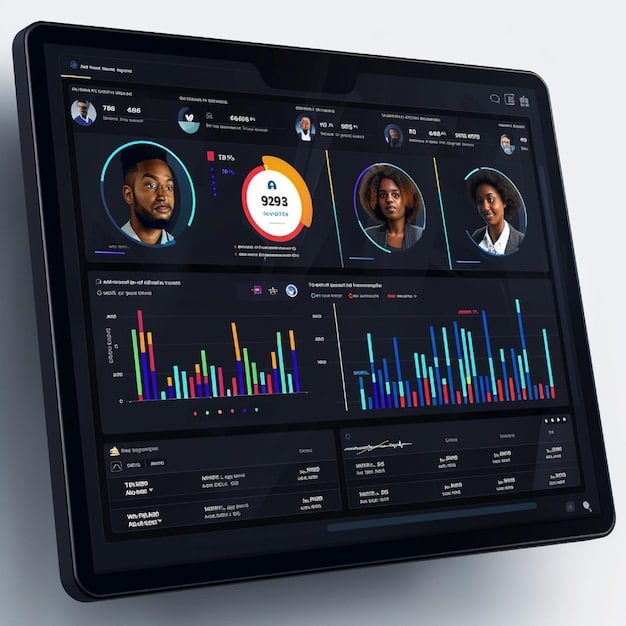Gen Z Micro-Influencers: Redefining US Marketing Authentically

The rise of micro-influencers, particularly among Gen Z, is fundamentally reshaping the marketing landscape in the US by prioritizing authentic connections over mass reach, fostering genuine engagement and trust between brands and consumers.
The marketing world is constantly evolving, perpetually seeking the most effective ways to connect with consumers. In recent years, a pivotal shift has emerged, driven largely by Gen Z: the undeniable rise of micro-influencers: how Gen Z is redefining marketing in the US with authenticity. This demographic, digital natives who value genuine connections, has propelled a new era where smaller, more relatable voices yield disproportionately powerful results compared to traditional celebrity endorsements.
The Authenticity Imperative: Why Gen Z Trusts Micro-Influencers
Gen Z, often characterized by their skepticism towards traditional advertising and their innate ability to discern genuine content from sponsored material, represents a unique challenge and opportunity for marketers. This generation has grown up immersed in digital media, witnessing the pervasive nature of highly polished, often inauthentic, brand messaging. Consequently, their trust is not easily earned, making authenticity a non-negotiable currency in their consumption habits.
Micro-influencers, typically defined as individuals with follower counts ranging from 1,000 to 100,000, bridge this gap. Their appeal lies precisely in their perceived relatability and genuine connection with their audience. Unlike mega-celebrities whose lives often seem aspirational and detached, micro-influencers live lives that mirror those of their followers. They discuss everyday struggles, present unfiltered opinions, and engage in conversations that feel less like marketing pitches and more like recommendations from a trusted friend.
Building Trust Through Relatability
The relatability factor is paramount for Gen Z. When a micro-influencer shares a product or service, it doesn’t feel like a top-down endorsement but rather a peer-to-peer suggestion. This horizontal influence is powerful because it taps into the fundamental human need for connection and shared experience. They are seen as experts within their niche communities, whether it’s sustainable fashion, niche gaming, or vegan cooking.
- Genuine Content: Micro-influencers often create raw, unfiltered content that resonates more deeply than highly produced ads.
- Direct Engagement: They engage directly with their followers, responding to comments and DMs, fostering a sense of community.
- Niche Expertise: Their smaller followings allow them to cultivate highly specific niches, making their recommendations more relevant.
- Personal Experiences: They share personal experiences and honest reviews, building credibility and trust over time.
This commitment to authenticity extends beyond simple product reviews. Gen Z expects brands and influencers alike to align with their values, whether it’s social responsibility, environmental consciousness, or inclusivity. Micro-influencers often organically embody these values, making partnerships feel more organic and less transactional. This inherent alignment strengthens the bond between the influencer, their audience, and the brands they choose to represent, creating a synergistic ecosystem built on trust.
From Mass Appeal to Niche Power: The Strategic Advantage of Micro-Influencers
The traditional marketing paradigm often focused on reaching the largest possible audience, assuming that sheer volume would translate into conversions. However, with the fragmentation of media consumption and the rise of highly specific online communities, this broad-strokes approach is rapidly losing its efficacy. Gen Z, in particular, gravitates towards niche content that speaks directly to their unique interests and identities. This shift has propelled micro-influencers into a strategic position, offering unparalleled advantages for brands seeking meaningful engagement.
Micro-influencers thrive in these niche environments because they are deeply embedded within specific communities. They understand the language, the inside jokes, the unspoken norms, and the specific needs of their audience in a way that generalized marketing campaigns simply cannot. This intimate knowledge allows them to craft messages that are not only relevant but also deeply resonant, bypassing the noise that plagues broader advertising efforts.
Reaching Hyper-Targeted Audiences
The ability to hyper-target is perhaps the most compelling strategic advantage offered by micro-influencers. Instead of casting a wide net, brands can collaborate with influencers whose followers are already predisposed to their product or service. This precision marketing drastically increases the efficiency of campaigns, ensuring that marketing spend is directed towards individuals most likely to convert.
- Higher Conversion Rates: Niche audiences are more receptive to recommendations, leading to better conversion rates.
- Cost-Effectiveness: Micro-influencers typically charge less than macro-influencers or celebrities, offering a higher ROI.
- Brand Affinity: Targeted campaigns foster a stronger sense of brand affinity among a loyal customer base.
- Rapid Feedback: Their engaged communities provide swift and valuable feedback for product development and marketing adjustments.
Moreover, the concept of “viral success” is often misunderstood. While mega-influencers might generate massive fleeting attention, micro-influencers cultivate “viral loyalty.” Their recommendations spark conversations within tight-knit groups, leading to organic word-of-mouth marketing that feels authentic and trustworthy. This cascade effect, where a recommendation from a trusted peer spreads through a network, is far more potent and sustainable than a single, high-profile celebrity endorsement. For Gen Z, who value community and connection, this type of peer validation is invaluable, making the strategic shift towards micro-influencers a logical and highly effective evolution in marketing.
Beyond Likes: Measuring Meaningful Engagement and ROI
In the evolving landscape of influencer marketing, the superficial metrics of follower count and “likes” are increasingly being relegated to the past, especially when targeting Gen Z. This digitally savvy generation looks beyond vanity metrics, valuing genuine connection and authentic interaction above all else. Consequently, brands engaging with micro-influencers must similarly shift their focus towards measuring meaningful engagement and, ultimately, the tangible return on investment (ROI) that these partnerships yield.
Meaningful engagement with micro-influencers transcends simple clicks or likes. It encompasses metrics like comment quality, shareability, direct messages received, and the depth of conversation spurred by the content. For Gen Z, active participation and dialogue are indicators of true interest and influence. They are more likely to engage with content that sparks curiosity, provides value, or aligns with their personal values, leading to a richer, more qualitative interaction than passive consumption.

Key Metrics for Genuine Impact
To accurately assess the effectiveness of micro-influencer campaigns, brands are employing a more sophisticated suite of analytics. This includes tracking not just traffic referrals but also conversion rates, customer lifetime value, and brand sentiment. The granular nature of micro-influencer communities allows for precise attribution, making it easier to connect specific campaigns to concrete business outcomes.
- Engagement Rate: Focus on comments, shares, and saves relative to follower count, indicating active audience participation.
- Conversion Tracking: Implement unique discount codes, custom landing pages, or affiliate links to directly track sales or leads.
- Brand Mentions & Sentiment: Monitor how the brand is discussed in comments and DMs, assessing qualitative feedback.
- Audience Demographics: Verify that the influencer’s audience genuinely aligns with the target Gen Z segment.
The ROI from micro-influencers often manifests not only in direct sales but also in enhanced brand credibility, increased brand awareness within a niche, and a deeper understanding of target consumer preferences. Because micro-influencers are often more affordable, a campaign involving numerous micro-influencers can collectively generate a higher ROI than a single, expensive collaboration with a celebrity whom Gen Z views with skepticism. This strategic investment in authentic voices represents a forward-thinking approach to marketing that prioritizes sustainable brand growth over ephemeral popularity, a strategy resonating deeply with the values and behaviors of the Gen Z consumer base.
The Evolution of Brand Partnerships: Co-Creation and Long-Term Relationships
The traditional model of brand endorsements often involved a one-off transaction: a brand pays an influencer to promote a product, and the influencer delivers a set piece of content. However, the rise of micro-influencers and the authenticity-driven demands of Gen Z are fundamentally reshaping this dynamic. The new paradigm emphasizes co-creation, genuine collaboration, and the cultivation of long-term relationships, moving away from transactional arrangements towards more symbiotic partnerships.
Gen Z values transparency and authenticity above all else. They can easily spot forced endorsements or inauthentic content. For brands, this means that simply handing over a product and a script to an influencer is no longer enough. Instead, successful partnerships with micro-influencers involve inviting them into the brand’s narrative, allowing them creative freedom, and treating them as true collaborators rather than mere宣传 channels. This shifts the influencer from a mouthpiece to a genuine brand advocate, whose passion for the product is evident and contagious.
Fostering True Collaboration
Co-creation ensures that the content produced resonates authentically with the influencer’s audience because it incorporates their unique voice, style, and understanding of their community. Brands are finding success by providing micro-influencers with creative briefs that outline objectives but allow ample room for personal touches, giving them the freedom to integrate the product into their regular content in a way that feels natural. This approach taps into the influencer’s expertise in their niche, leveraging their understanding of what truly connects with their followers.
- Creative Autonomy: Granting influencers freedom to integrate products organically enhances content authenticity.
- Joint Campaign Planning: Involving influencers in the creative process from conception strengthens partnership bonds.
- Product Development Input: Leveraging influencer feedback can provide valuable insights for product improvements.
- Long-Term Ambassadorships: Sustained partnerships build deeper trust and continuous brand exposure.
Furthermore, establishing long-term relationships with micro-influencers cultivates a sustained cycle of brand advocacy. When influencers are genuinely invested in a brand, their promotion becomes less about a single campaign and more about continuous endorsement over time. This fosters a sense of loyalty not only from the influencer but also from their audience, who witness a consistent and genuine connection. For Gen Z, seeing an influencer consistently use and recommend a product over months or years is far more compelling than a one-off post, solidifying the brand’s presence in their minds and building lasting trust.
Challenges and Considerations: Navigating the Micro-Influencer Landscape
While the benefits of collaborating with micro-influencers are compelling, navigating this evolving landscape comes with its own set of challenges and considerations. For brands accustomed to more traditional marketing approaches, the decentralized nature of micro-influencer marketing requires a shift in strategy and execution. Understanding these potential pitfalls is crucial for maximizing the effectiveness and genuine impact of these partnerships with Gen Z consumers.
One primary challenge lies in the sheer volume and diversity of micro-influencers. Identifying the right micro-influencer for a specific brand or campaign requires significant research and vetting. Brands need to look beyond basic follower counts and delve into engagement rates, audience demographics, content quality, and most importantly, authenticity markers. A mismatch can lead to wasted resources and, worse, a perception of inauthenticity from Gen Z, which can damage brand reputation.

Ensuring Brand Safety and Compliance
Maintaining brand safety and ensuring compliance with regulatory guidelines, particularly those from the FTC (Federal Trade Commission) regarding disclosures, is another critical consideration. Micro-influencers might be less familiar with these requirements than their macro counterparts, necessitating clear communication and education from the brand. Failure to comply can lead to legal penalties and significant reputational damage, especially with a discerning Gen Z audience that expects transparency.
- Thorough Vetting Process: Implement rigorous checks to ensure influencer values align with brand ethics and authenticity.
- FTC Disclosure Compliance: Clearly instruct influencers on proper disclosure language for sponsored content.
- Content Control vs. Authenticity: Find a balance between creative freedom and ensuring brand messaging accuracy.
- Scalability of Outreach: Develop efficient processes for managing multiple micro-influencer relationships simultaneously.
Furthermore, managing multiple micro-influencer relationships can be administratively intensive. Unlike a single celebrity endorsement, a micro-influencer campaign might involve dozens, if not hundreds, of individual partnerships, each requiring separate contracts, creative briefs, communication, and performance tracking. Brands need robust internal systems or specialized platforms to manage these relationships efficiently without compromising the personalized approach that makes micro-influencers so effective. Despite these challenges, the ability of micro-influencers to connect profoundly with Gen Z through authenticity makes overcoming these hurdles a worthwhile strategic investment for future-forward marketing initiatives.
The Future is Niche: How Micro-Influencers Are Shaping Marketing Beyond Gen Z
While Gen Z has undeniably been the catalyst for the micro-influencer phenomenon, their impact is swiftly extending far beyond this demographic, signaling a fundamental, long-term shift in the broader marketing landscape. The principles of authenticity, relatability, and niche expertise that resonate so strongly with Gen Z are proving universally appealing, influencing consumer behavior across generations and setting new standards for effective brand communication. The future of marketing is increasingly looking niche, decentralized, and deeply personal, largely thanks to the groundwork laid by micro-influencers.
This macro-trend towards niche marketing is driven by a broader societal shift: the fragmentation of traditional media and the rise of personalized digital experiences. Consumers of all ages are now accustomed to curating their own content feeds, seeking out voices that speak directly to their specific interests and values. Generalist content is increasingly overlooked in favor of highly relevant, specialized insights. Micro-influencers, being inherently specialized, are perfectly positioned to capitalize on this evolving consumption pattern, regardless of the audience’s age.
Expanding Influence Across Demographics
As micro-influencers demonstrate their effectiveness with Gen Z, other demographics are noticing and responding positively to similar authentic connections. Older generations, while perhaps less digitally native, still value trust and genuine recommendations. A micro-influencer focusing on specific financial advice, DIY home improvement, or niche travel experiences can resonate just as strongly with Gen X or Baby Boomers, provided the content is authentic and relevant to their lives.
- Targeted Reach: Micro-influencers effectively reach highly specific interest groups across all age brackets.
- Enhanced Credibility: Their specialized knowledge builds trust and authority within their chosen niches.
- Community Building: They foster engaged communities that transcend simple follower counts, leading to brand loyalty.
- Sustainable Marketing: Authentic, ongoing relationships offer a more enduring marketing approach than fleeting celebrity endorsements.
Ultimately, the enduring success of micro-influencers points towards a future where marketing is less about shouting from the rooftops and more about whispering in trusted ears. It’s a move away from mass appeal towards meaningful engagement, from broad campaigns to hyper-targeted conversations. Brands that recognize this shift and invest in building genuine, long-term partnerships with micro-influencers are not just adapting to a passing trend; they are future-proofing their marketing strategies, ensuring relevance and resonance in an increasingly fragmented yet interconnected world, a world redefined by the power of authentic voice and niche expertise.
Navigating the AI Era: Micro-Influencers as a Human Counterbalance
As artificial intelligence (AI) increasingly permeates various aspects of marketing, from content generation to data analysis, a crucial question arises: how do human-centric strategies like micro-influencer marketing fit into this AI-driven future? Far from being made obsolete, micro-influencers are emerging as an indispensable human counterbalance, offering the authenticity, empathy, and nuanced connection that even the most advanced AI struggles to replicate. For Gen Z, who view AI with a mix of fascination and skepticism, this human element becomes even more vital.
The core strength of a micro-influencer lies in their humanity. They share real experiences, express genuine emotions, and facilitate two-way conversations that build trust and community. While AI can analyze data to identify trends, optimize content for engagement, or even generate text and images, it cannot replicate the lived experience, the personal touch, or the inherent relatability of a human individual. This distinction makes micro-influencers uniquely positioned to thrive in an era where AI might standardize and automate, leaving a void for genuine human connection.
Leveraging AI to Enhance Human Creativity
Instead of viewing AI as a replacement, forward-thinking brands and micro-influencers are leveraging it as a powerful tool to enhance efficiency and effectiveness. AI can assist micro-influencers by identifying optimal posting times, analyzing audience sentiment, suggesting trending topics, or even streamlining administrative tasks, freeing up more time for creative content creation and direct audience engagement. This collaborative approach ensures that the human element remains at the forefront, enriched by technological capabilities.
- AI for Audience Insights: Using AI tools to understand niche audience preferences and optimize content strategy.
- Automated Outreach: Employing AI to identify suitable micro-influencers and streamline initial contact.
- Sentiment Analysis: AI can help gauge audience reaction to content and brand mentions, providing valuable feedback.
- Content Optimization: AI can suggest keywords or content structures to improve discoverability without sacrificing authenticity.
For Gen Z, who are highly aware of the capabilities and limitations of AI, the human touch of micro-influencers offers a refreshing contrast to potentially algorithm-driven content. They appreciate content that feels genuine, unscripted, and born from real-life experiences. As AI continues to evolve, the demand for authentic, human connections will likely intensify, further solidifying the role of micro-influencers as vital conduits of trust and relatability. Their ability to foster genuine community and deliver nuanced, empathetic content will be increasingly invaluable, ensuring their continued relevance and growth in an AI-powered marketing world.
| Key Point | Brief Description |
|---|---|
| ✨ Authenticity First | Gen Z values genuine, relatable content, leading to higher trust in micro-influencers. |
| 🎯 Niche Power | Micro-influencers offer hyper-targeted reach and higher conversion rates within specific communities. |
| 🤝 Co-Creation | Brand partnerships are evolving into long-term, collaborative relationships for deeper engagement. |
| 👤 Human Element | In the AI era, micro-influencers offer irreplaceable human connection and genuine trust. |
Frequently Asked Questions About Micro-Influencers & Gen Z Marketing
Gen Z values authenticity and relatability. Micro-influencers are seen as more genuine and trustworthy because they share similar everyday lives and experiences, fostering a peer-to-peer connection that celebrity endorsements often lack. This makes their recommendations feel more like advice from a trusted friend than a paid advertisement.
Authenticity for Gen Z stems from genuine engagement, unfiltered content, and consistent values. Micro-influencers who share personal experiences, respond directly to their audience, and show genuine passion for the products they promote are perceived as authentic, building lasting trust rather than fleeting interest.
Brands measure ROI by focusing on metrics like engagement rate (comments, shares), conversion rates via unique codes or links, and qualitative brand sentiment. They track sales directly attributable to campaigns, analyze website traffic referrals, and assess improvements in brand perception, moving beyond superficial vanity metrics.
Micro-influencers can genuinely impact sales due to their hyper-targeted reach and high engagement rates within niche communities. Their recommendations carry significant weight with their followers, often leading to direct conversions. While they also build targeted brand awareness, their ability to drive action is a significant advantage for brands.
AI doesn’t replace micro-influencers but enhances their effectiveness. It helps identify suitable influencers, provides audience insights, optimizes content strategies, and streamlines administrative tasks, allowing influencers to focus on creating authentic content and fostering human connections. AI is a tool to amplify, not substitute, the human element.
Conclusion
The profound impact of Gen Z on the marketing landscape, particularly through their embrace of micro-influencers, cannot be overstated. Their demand for authenticity, their skepticism towards traditional advertising, and their inherent connection to niche communities have reshaped how brands engage with consumers in the US. By prioritizing genuine voices and fostering real relationships, micro-influencers offer a pathway to deeper engagement and more meaningful ROI, proving that in an increasingly digital world, the human touch remains the most powerful currency in building brand loyalty. This shift is not merely a trend but a fundamental redefinition of effective marketing, with authenticity as its unwavering cornerstone.





